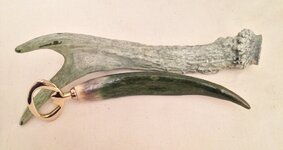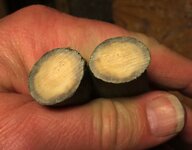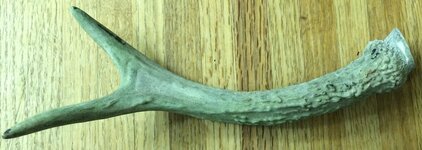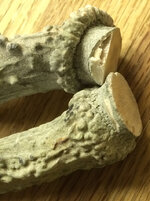TimS124
Member
I was sent some old antler from a friend of a friend. These were smaller antlers so they were essentially left in a barn for who knows how long.
The surface wasn't as smooth as the other antlers I've worked with…wasn't terribly rough just felt like it had a beefy layer of dust/grime when I first handled these pieces.
The rear antler in the enclosed picture shows what the pieces looked like when I got them…mostly a dull, dusty, grey with a tiny hint of a greenish tint.
I tried wiping that layer off with a damp paper towel, but almost nothing came off…the grey turned somewhat greener while damp though (but nothing as bold as what you can see in the bottle opener made from one of these pieces).
I sliced off the tip of one of the grey antlers, drilled a 7mm hole in the cut end, shaped it against a sanding belt, and wiped on boiled linseed oil.
Normally, the antler that's exposed by sanding is very white. The BLO yellows it up slightly so it blends with the unsanded portions (well, at least on all prior antler pieces I've worked).
This time, the unsanded part turned dark green when the oil hit it! The transformation was pretty dramatic and, despite the hint of color when I dampened it during cleaning, that much color change was quite unexpected.
Fortunately, it still looks pretty cool to me and to the person it's going to…but it still weirded me out quite a bit.
I've also included a photo of the cross section of the piece that became the bottle opener in the first picture…you can see that the discoloration runs pretty deep, it's not really practical to sand through it all on the entire antler. I'd lost far too much detail and would be left with fairly skinny pieces.
Anybody else ever see this happen?
The surface wasn't as smooth as the other antlers I've worked with…wasn't terribly rough just felt like it had a beefy layer of dust/grime when I first handled these pieces.
The rear antler in the enclosed picture shows what the pieces looked like when I got them…mostly a dull, dusty, grey with a tiny hint of a greenish tint.
I tried wiping that layer off with a damp paper towel, but almost nothing came off…the grey turned somewhat greener while damp though (but nothing as bold as what you can see in the bottle opener made from one of these pieces).
I sliced off the tip of one of the grey antlers, drilled a 7mm hole in the cut end, shaped it against a sanding belt, and wiped on boiled linseed oil.
Normally, the antler that's exposed by sanding is very white. The BLO yellows it up slightly so it blends with the unsanded portions (well, at least on all prior antler pieces I've worked).
This time, the unsanded part turned dark green when the oil hit it! The transformation was pretty dramatic and, despite the hint of color when I dampened it during cleaning, that much color change was quite unexpected.
Fortunately, it still looks pretty cool to me and to the person it's going to…but it still weirded me out quite a bit.
I've also included a photo of the cross section of the piece that became the bottle opener in the first picture…you can see that the discoloration runs pretty deep, it's not really practical to sand through it all on the entire antler. I'd lost far too much detail and would be left with fairly skinny pieces.
Anybody else ever see this happen?




